Cooking is a survival skill. Its one of the most overlooked but for the longest time it was prioritized. That is because starvation was always looming. For most of human history starvation sat quietly in the corner ready to reach out and take another.
For the pioneers it was no different. In fact, it was even worse. Well, no one had it worse than the children of the pioneers. They had about a 20% chance of not making it to 1 year old! It was just as hard to make it to 15 years old. Once you established yourself you had a much better chance of a long life.
We could go down the litany of threats like disease, injury, native Americans and so on. Most of the trouble came from malnutrition and the inability to develop a powerful immune system. We know this now because of advances in nutrition and a better understanding of epidemiology.
You can’t raise kids on cabbage water in the wild west. Creativity in cooking was a hallmark of the pioneers, for this reason. They took often overlooked or discarded ingredients and turned them into food. Some of these weird foods are still eaten and enjoyed today!
Calf Foot Jelly
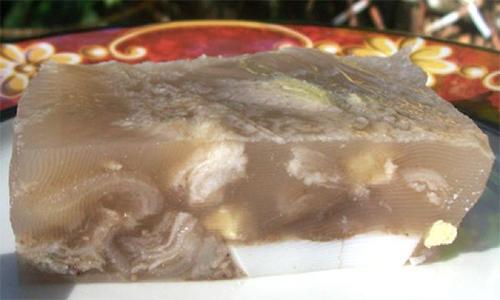
Do you know where that yummy strawberry gelatin comes from? Many vegetarians and vegans have given up jelly because it comes from animals.
Calves foot jelly is no different. It is something of a casserole served cold. Really, it would be categorized as a terrine in French cooking.
- You need 2 calves feet cut in cross wise sections (find a butcher)
- 2 Carrots
- 1 Onion
- 4 Cloves of Garlic, minced
- 3 Hard Boiled Eggs
Start buy bringing your calves feet to a boil. Skim the scum that rises to the top. Remove the calves feet and start them in another pot of cold water. To this pot add your carrots and onions diced. Bring to a simmer and cook on the lowest setting for 6 hours.
Next, remove the calf’s feet. Remove the meat from the bones and discard them. Chop the meat, tendon and cartilage up in small pieces. Then mix with your 4 cloves of garlic minced fine.
In a terrine or clear glass dish slice your hard-boiled eggs and lay them on the bottom of the dish or terrine. Next spread your meat and garlic mixture over the eggs.
Finally, pour the remaining liquid over the mix, slowly. Try not to disturb your eggs.
Let this mix cool and harden. Then cut into squares to serve, chilled.
Related: The Ultimate Chicken Meat Processing Guide for Preppers
Sweet Potato Coffee
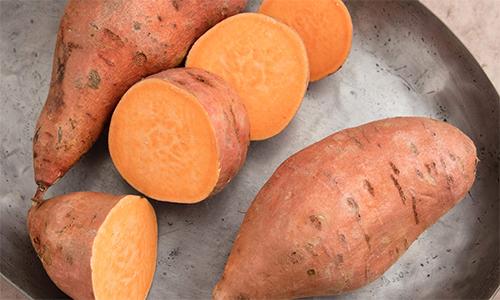
The sweet potato was undoubtedly used here as a sugar substitute and as a means of stretching that coffee supply. Remember, coffee was coming from a long way away, as it does today.
To recreate it you can take thin sliced sweet potatoes and dehydrate them in the sun or in an oven till they are dry. This will take about 8 hours in a conventional oven on its lowest setting. Outdoors it will likely take days in the sun.
Grind the sweet potato in a mill or coffee grinder. Add two tablespoons of coffee grounds to three tablespoons of your sweet potato grounds and brew as usual.
Related: 8 Old West Cowboy Recipes
Acorn Bread
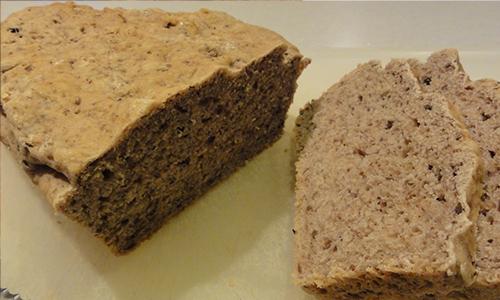
You didn’t cross through many wheat fields on your trek west and most people didn’t have the time sit down and separate the chaff out anyway.
That meant you used the acorns around you to create flour. Making acorn bread from acorn flour is a similar process to making bread with regular flour. You could add yeast, salt, sugar, fat of some kind to make the bread more palatable.
The process that deserves your attention is the making of the flour itself!
- You start by removing the cap from the acorns and roasting them.
- Next your remove the meat from the center of the roasted acorns.
- After this you are going to bring the meat to a boil several times, starting with cold water. This removes the tannins.
- At this point you should have acorn meat that is not as bitter as it was.
- From this point you are going to roast the meat until it is dry. Slow and low heat.
- Once dried the meat can be run through a food processor and you will have a nice acorn flour.
Related: How to Make Amish Sweet Bread
Mud Apples
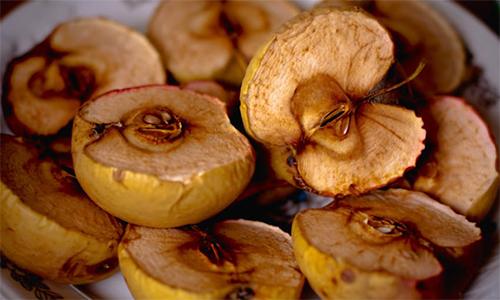
The pioneers stole this little recipe from the native Americans. It is a method of cooking apples in coals without burning them. Don’t forget, they couldn’t just wrap them up in aluminum foil.
If I were going to reproduce this one, I would slice the apples in half, scoop out the center and pack it with some brown sugar and oats. That would be a serious campfire meal.
- Thick Mud
- Apples
Coat your apples in a thick layer of mud. Don’t worry you aren’t eating the skin. Make sure the apples are covered completely
Bury your mud covered apples in coals for about 45 minutes. The mud will harden and can be peeled off. Remove the skin and spoon out that delicious roasted pulp.
Related: How to Make Your Own Apple Sugar
1876 Cottage Cheese
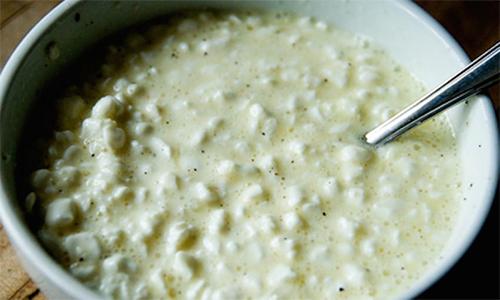
The milk of the pioneer age was not pasteurized. The cream was not removed. This meant that milk did very interesting things over time. You could also make several different things using that milk.
- The milk could be used to make fine cheese
- The cream could be skimmed to make butter or whipped cream
- The milk could be separated using vinegar or lemon juice to make buttermilk
In this case the milk would be allowed to go sour and form what is called clabber. This is when sour milk globs together and looks more like sour cream.
At this point you would skim the cream off as it would not sour as fast as the milk below it. Set the clabbered milk on very low heat and when it congeals cut it into 1 inch squares.
Next you would place a colander into the clabber and dip off any of the whey that rises through the colander. You are doing this to remove everything but the curds. After a while the clabber will become firm. Rinse it lightly with cold water.
Next you are going to place the clabber into the colander or into some cheese cloth and ring out any excess water. To make the cottage cheese, crumble your curds into a bowl and mix with thick cream.
You can add fruit puree to your cottage cheese, or you can add fresh black pepper. That’s my favorite.
Related: How to Make Cheese from Powdered Milk
Kid Pie
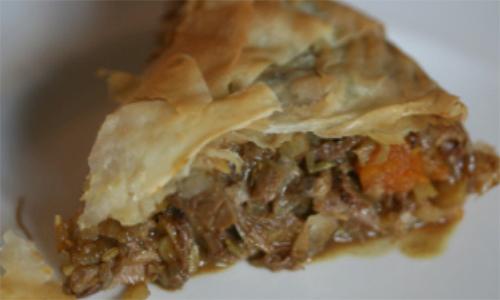
This is not something from a spooky children’s story. However, this is a recipe that the pioneers would have created once they settled and started raising goats. Don’t forget a kid is also a baby goat.
This pie would have been made using a young fatty kid. Apparently fatty goats were not favorable to roasting in the pioneer days.
It was essentially a covered pie with tons of chopped parsley and chopped bits of young goat meat. The pie would have been cooked for about an hour until the meat was cooked through and the crust starting to brown.
A mixture of eggs and vinegar would then be whisked together and poured into the steam holes in your layer of pie crust.
How long would it take for the eggs to firm up? Well, the pioneers would use an interesting “TIMER” for things like this. In this case you would “Say the lord’s prayer three times…” and the pies would be finished.
Related: How To Pickle Meat
Vinegar Lemonade
We have a stranglehold on imports and exports. Our international trade and rapid shipping methods mean that things like bananas, coffee, lemons and avocadoes are just a quick drive away. None of these items would have been naturally occurring on the trek west.
Still, people liked them. When it came to lemonade it was not just about that sweet and sour contrast in a refreshing drink but also about Vitamin C deficiency. As we mentioned malnutrition was a big problem, even if your tummy was full on breads and potatoes.
In a glass mix 2 tablespoons of apple cider vinegar with 2 tablespoons of sugar. Fill with water. Done
You know, on the surface these recipes sound like something you would run from. However, when executed well, I have to imagine these things were pretty delicious. You can sign me up for a kid pie or a loaf of acorn bread any day.
The ultimate lesson is that we, as preppers, are headed for lean times. Its best to know how to make the most of what is available to you.
If nothing else, start learning the basic cooking methods and employ them on a nightly basis at home. It’s like Miyamoto Musashi said, “If you know the way broadly you will see it in everything.”
You may also like:
11 Frontier Survival Hacks Worthy of Daniel Boone
10 Things Cowboys Carried With Them in the Wild West to Survive (Video)
Pioneer Recipes That Survived The California Trail
11 Things The Pioneers Carried With Them On The Oregon Trail

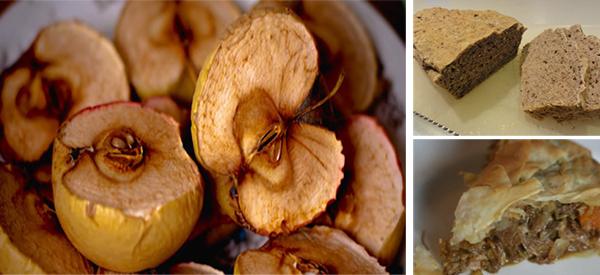














I don’t know which would take more time, threshing wheat or treating acorns. During WWII, my wife would knock the hulls off of rice by “churning” them with a stick in a large sake bottle. It wouldn’t completely take the hulls off, but take enough of the hull off to make the rice more edible.
I suspect that wheat could be threshed in much the same manner. Pour the kernels of wheat with the hulls on into a large glass jar and pound them with a broom handle until enough of the hull is knocked off to be able to grind and process the wheat.
Most modern varieties of wheat are free threshing and fall out of the flume readily.The farmers here get a head or two of wheat, rub them together in the palms and the grains fall out if the crop is ripe for harvesting. Sometimes they just check the top grains since they are the last to ripen and chew a few to check for hardness. If they are brittle and crunchy then it’s ready but sometimes they’re soft and doughy and they wait for another few weeks.
In our climate we have 1 opportunity each year to get it right ?
Thanks for the post, Ginny. Nothing like getting the word from someone who has been there and done it.
Are the modern varieties GMO or are they heirloom? In an EOTW situation, GMO would be fine for the first year or two but then the preppier would want to go heirloom. If the easy-off type of wheat kernel (or, I guess more accurately,
flume) is heirloom, then that would be the way to go from the start.
That should have read ‘…Most modern varieties of wheat are free threshing and fall out of the glume readily…’ Sorry.
None of our wheat is GM and to my knowledge GMO wheat has not been released in Australia at this stage and I hope never is. I don’t know about the US.
Some are heirloom but which variety is grown here depends a lot on market demands and region as with most things farmers grow. Our wheats are bred locally for local conditions, no red wheats, mostly hard whites, noodle or durrum; maybe a few specialty types, and then they vary in season length, much like you would have in the USA. Grain varieties tend to be replaced every 5-10 years here as newer varieties are bred and released for a particular market or purpose although we are growing one variety that is 15-20 yrs since release and it still out performs the replacement varieties on our farm. We grow a noodle variety (protein 9.5- 10.5%) but in all honesty I use if for just about any cooking I do including bread. I don’t rely on it solely and like most folks buy my bread from the supermarket but I needed to know how to do it from seed to table, just for my own benefit.
If you’re after a true heirloom wheat try these: Spelt, Emmer and Einkorn are hulled wheats and not free threshing so the glume takes some getting off before eating but they are some of the oldest forms of wheat closely related to the wild wheat grasses. Wikipedia can give you the rundown on their genetics if anyone is interested. Khorasan or Kamut wheat I think is the similar but it is quite good being almost double the size of standard wheat kernels and producing in relatively poor conditions. Bob’s Red Mill sells wheat kernels/berries and I can vouch for some of them growing quite well in my garden in season. Since it’s an imported product here it is NOT cheap but it allowed me some trial growing to see how they would or could perform here.
Anyone interested in growing grains would do well to read Small-Scale Grain Raising by Gene Logsdon. In commercial practice wheat here produces between 2.5 – 6 tonne per hectare and is sown at around 100kg/ha in a rain fed system. In the EU it is not unusual to get 30t/ha, different climate, soils etc. Without some foreknowledge it would be hard to estimate what your area would produce.
Will it be worth growing grains in the EOTW? I for one would miss it so would try to grow some. It wouldn’t be easy but then I’m reminded of the biblical quote from when Adam and Eve were cast out of the garden of Eden: ‘…In the sweat of thy face shalt thou eat bread…’ Genesis 3:19
I’d like to try some hull-less (naked) oats too.
I was mislead by your nom de plume, Ginny. I assumed that WA was the state of Washington here in the U.S. I had forgotten that actually you were in Western Australia. Sorry for being so provincial. Eastern Washington state is also a large wheat growing area, so it seemed to make sense that if you live in eastern Washington state, you might well be growing wheat on a ranch there.
According to Mathew 12 it’s pretty easy to prepare a snack when crossing a field of ripe wheat.
Kid pie, yummy, no hardship there.
Calf foot jelly, I see lots of 3 footed beeves trying to keep up with the wagon train.
Hmm, watching video of Patriots trying to intercept Iranian missiles. 2020 off to a scary start.
The term “fatty kid” sort of threw me. Is that a kid that is abnormally fat or is it some kind of problem (other than juvenile obesity) with the goat? I will have to admit I have never roasted a goat, kid or otherwise, over an open fire — well, open fire or by any other means. I must be abnormally clueless when it comes to goats. Why would a fatty kid not be amenable to roasting? Pigs are roasted on a spit over an open fire and they certainly qualify for the sobriquet “fatty”.
Another coffee substitute would be chicory which I’m sure most people have heard of. It’s often planted in perennial pastures these days in some areas but you can grow it as a leafy green in the garden.
I’ve not heard of mud apples but many things can be cooked this way. Small birds were often cooked in mud after being drawn (guts removed) and the feathers all came out in the mud when cooked so no need to pluck them. It’s also worth noting that a bed of coals can cook many things with only a little charring. Potatoes work well like this and a bit of char doesn’t hurt anyway. We never use foil for spuds in the coals.
The vinegar lemonade was interesting. My father always put a lid full of ACV in water over summer as he said it was more thirst quenching than plain water. No sugar though and probably better for us without it anyway 🙂
I’m fortunate to have lemons nearly all year round and since giving up tea and coffee, I have a thick slice of lemon with hot water instead.
With acorns you can harvest and process, leaving them whole until you need them. They’d be insurance for lean years, and if you gathered and processed them during a mast year, you’d want to gather enough to see you through two years.
Acorns can be tasty.
I was far too old for our Middle East follies, so haven’t had a chance to view Middle Eastern culture up close and personal. Also folks who study the bible closely may be able to answer the question. I seem to recall accounts of certain nationalities in the Middle East roasting goats on a spit over an open fire. I believe the bible also makes reference to roasting goats although I certainly can’t quote chapter and verse. So I still don’t have an answer as to why a “fatty” kid is not amenable to roasting on a spit over a fire.
And the second part of the question: Just what constitutes a “fatty” kid — I mean other than Tommy the fat kid in third grade at a time when everyone else in school was rather lean due to wartime restrictions on a lot of different foods. No worry about too much sugar in those days. And with oleomargarine the only spread available, not too much worry about too much fat either. It was very easy to believe that oleo absolutely, positively was not butter. Not even the dullest kid in class was fooled into believing that the white grease with the orange pill massaged into it was real butter.
I’ve been thinking about the ‘fatty kid’ (I had to laugh at your reference to Tommy, the fat kid from school) and was wondering if it maybe had more to do with the loss of fat into the fire where it just burns and smokes rather than being eaten and providing energy to the hungry horde waiting for supper. It would be a terrible waste when you’re starving or doing it tough. At least in the pie we all get to share the grease 🙂
I remember my parents trying margarine but the experiment didn’t last long. My mother then started whipping up the pound of butter with a cup +/- of EV olive oil. Made the butter spreadable, tasted like butter still and went twice as far. Now you can buy it like that but not in those days.
During WWII here in the States, your choices were Miracle Whip which was a Kraft Chemical Concoctions “spread” or white oleomargarine with a orangey-yellow pill that one was supposed to massage through the block of oleomargarine to make it resemble butter. Unfortunately, it didn’t resemble butter and certainly didn’t taste like butter. I can remember the taste to this day, a nasty, greasy bland substance. You mouth felt like you had be taken to the service station and been lubed.
Butter generally was unavailable unless one was willing to pay black market prices. My parents as a matter of conscience absolutely refused to play the black market game, so we never had butter because it was always “unavailable” at the butcher shop where butter was sold for some reason. Some of our neighbors who were perhaps less finicky about black market dealings seemed to have butter.
My mother never mixed it with olive oil as, for us, it was just plain unavailable. That’s certainly a good idea for getting a little extra mileage out of butter. It had not occurred to me. Thanks for mentioning it, Ginny. A good EOTW tidbit of helpful information.
I think my parents used dripping instead of butter during the war and my father I know grew up during the depression so no butter then other than when he worked on farms. He used to say dripping wasn’t too bad – worse where there was none.
There was rationing during the war so any butter ration was probably used for baking where the taste was more important but it was a bit before my time 🙂
Margarine was advertised in the 50’s and 60’s as being a healthy substitute for butter. Didn’t like it then, don’t like it now and I refuse to buy it. If butter is going to kill me then at least I’ll die enjoying my food.
The “vinegar lemonade” is something I drink nearly everyday to help ensure kidney stones don’t grow to the point of being unbearably painful before passing.
I add 4 teaspoons to a 16 oz bottle of water, and sweeten to taste with stevia.
When chilled, it’s actually very refreshing in the summer.